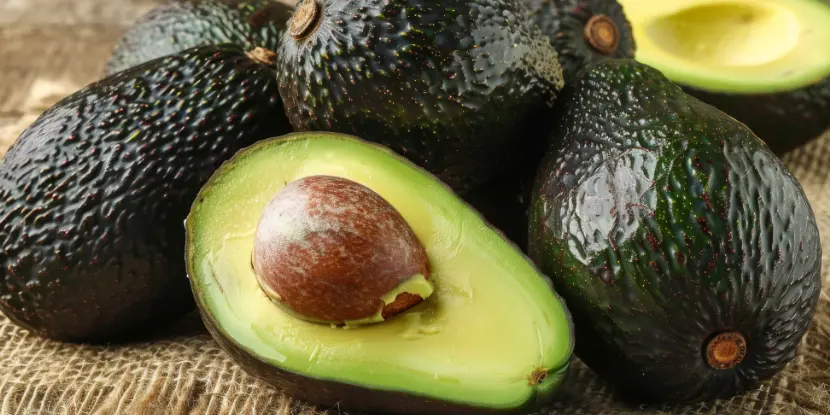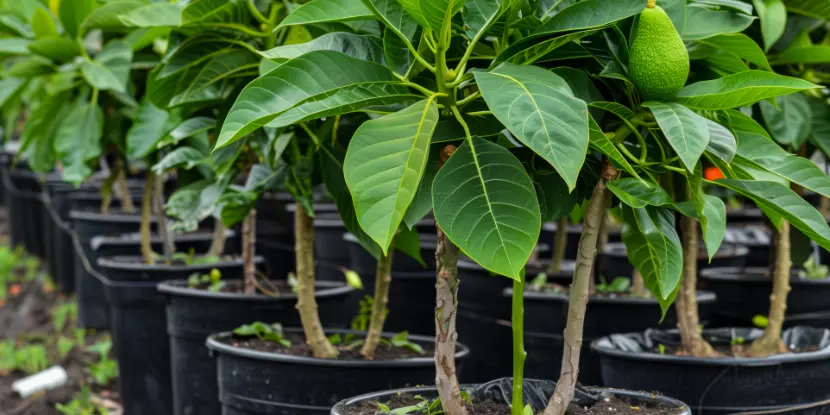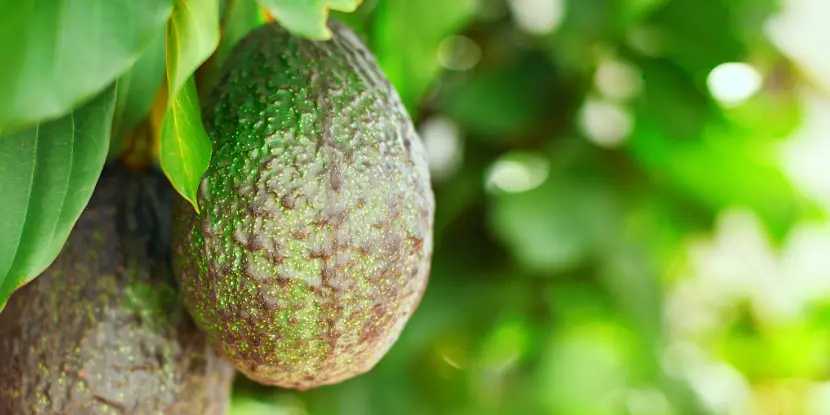Avocados are delicious and nutritious (said Captain Obvious).
They’re also remarkably easy to grow in Southern California yards.
The tree hails from Mexico, which also gave us the poinsettia, zinnia, and mariachi music. Persea americana dates back thousands of years and was first cultivated by the Mesoamerican tribes around 5,000 BCE.
The Aztecs called the fruit “ahuacatl,” or testicle, for its shape. Those jolly Aztecs always enjoyed a good off-color joke.
Avocados were introduced to the United States in the early 20th century and have since become a fixture in trendy diets. Several Southern California cities built their fortunes on the “hipster pear.”
Avocado Health Benefits
Avocados are packed with essential nutrients and vitamins K, E, C, and B-6.
- They contain more potassium than bananas,
- Their fiber aids in digestion and promotes a feeling of fullness.
- Their monounsaturated fats can lower cholesterol levels and the risk of heart disease.
- Their antioxidants have anti-cancer properties.
- They reduce inflammation.
So what are you waiting for? The sooner you plant, the sooner you reap the rewards!

A sliced avocado with exposed seed (pit) — ready for planting!
Popular Avocado Varieties
- Hass is the most widely grown avocado variety in California. It has a creamy texture and rich flavor, and its pebbly skin darkens from green to purplish-black as it ripens.
- Fuerte is a hybrid of the Guatemalan and Mexican avocado species. It has smooth, green skin, a milder taste, and is relatively cold-tolerant.
- Bacon, with its green, smooth skin and a creamy flavor, is less oily than Hass. It can flourish in cooler temperatures.
- Zutano has shiny, green skin and a mild, somewhat watery flavor. It ripens early and is often used to extend the avocado season in California.
- Pinkerton is a high-yield avocado with dark green, bumpy skin and a long shape. It has a small seed and a high oil content, making it very creamy.

Illustration of avocado varieties showing their different sizes and shapes.
Starting an Avocado Tree from Seed (the Pit)
Starting an avocado tree from seed is a snap. We’d argue that peeling an avocado is harder than growing an avocado tree.
- Carefully extract the seed from a ripe avocado and rinse it under lukewarm water.
- Insert three to four toothpicks around the middle of the seed.
- Suspend the seed in a glass of water with the pointed end up and the flat end submerged.
- Place the glass in a sunny spot and change the water every few days. Roots and a stem should appear within 2–6 weeks.
Once your seed has sprouted and the roots are substantial, transplant it into the soil (instructions to follow).

An avocado pit suspended in water for sprouting.
Starting an Avocado Tree from Cuttings
Starting an avocado tree from a cutting ensures your new tree has the same desirable traits as the parent plant.
- Select a healthy, young branch from an avocado tree. The branch should be about 6 inches long with several leaves.
- Make a clean cut just below a leaf node (the point where a leaf grows from the stem).
- Remove all but the top two or three leaves. Dip the cut end of the branch into a rooting hormone powder to encourage root development.
- Plant the cutting in a small pot filled with a well-draining potting mix. Cover the pot with a plastic bag or a clear dome to create a mini-greenhouse effect, keeping the soil moist and the humidity high.
- Place the pot in a warm, bright location, but out of direct sunlight. Keep the soil consistently moist but not waterlogged.
- New leaves and roots should begin to develop within several weeks to a few months.
- Once the cutting is firmly rooted and shows new growth, you can remove the plastic cover.
Ideal Temperatures
- Avocado prefer temperatures between 60-85°F (15-29°C).
- They can withstand short cold periods, but prolonged exposure to temperatures below 50°F (10°C) can harm them.
- In colder climates, grow your avocado plant indoors or in a greenhouse.
- In hotter climates, give your plant adequate shade to prevent leaf burn.
Light Requirements
- Avocado trees need lots of sunlight, at least six hours per day.
- Young plants can benefit from partial shade.
- Rotate your plant regularly (if potted) for even growth.
Soil Conditions
- Avocado trees prefer slightly acidic soil with a pH of 6–6.5.
- Amend your soil with compost, peat moss, or other organic matter to improve drainage and provide nutrients.
- Avoid heavy clay soils, which can cause root rot.
- If planting your tree in a container, use a well-draining potting mix with added perlite or vermiculite for proper drainage.

Young avocado trees growing in containers.
Planting Location
Avocado trees need well-draining soil with plenty of organic matter.
- Choose a sunny spot for planting and ensure that the tree will have enough space as it grows (they can reach up to 80 feet tall!).
- Avoid areas with strong winds or frost pockets.
- If planting multiple trees, leave at least 10–15 feet of space between them.
Planting Instructions
- Dig a hole twice as wide and deep as the root ball.
- Carefully remove the tree from its container and gently loosen any matted roots before placing it in the hole.
- Fill the hole with soil, ensuring the top of the root ball is level with the surrounding ground.
- Water thoroughly and add a layer of mulch around the tree to retain moisture.

Bunched unripe Haas avocados on the tree.
Caring for Your Avocado Tree
- Water regularly, keeping the soil moist but not soaked.
- Fertilize with a balanced fertilizer every 3–4 months according to package instructions.
- Prune your tree in early spring to promote new growth and maintain its shape. Remove dead or crowded branches.
- Protect young trees from pests with organic pesticides or companion planting techniques.
Avocado Tree Diseases
Like all plants, avocado trees are susceptible to various diseases affecting their health and productivity.
- Root rot results from overwatering and poor drainage. Symptoms include wilting leaves, yellowing foliage, and a soft, mushy root system. Solution: Ensure proper drainage and water the tree only when the top inch of soil is dry.
- Leaf spot is a fungal infection that causes dark, water-soaked areas on the leaves and leaf drop. Solution: Maintain good air circulation around the tree and avoid overhead watering.
- Anthracnose is another fungal disease that affects the fruit and leaves, leading to dark lesions and premature fruit drop. Solution: Regularly clear fallen leaves and debris, and consider using fungicidal treatments if necessary.
Knowing When to Harvest Your Avocados
Harvest time will vary depending on the type of avocado tree you’ve cultivated and the climate. Most varieties are ready for harvest within 6–8 months after flowering. Here’s how to know when it’s time to pick your avocados:
- The fruit should have reached its full size, which can vary by variety.
- Many avocado varieties will change color as they ripen. For example, Hass avocados transition from green to a dark purplish-black.
- Gently twist the avocado; if it comes off easily without the stem breaking, it’s ready for harvest.
- Harvest a sample and allow it to ripen at room temperature. If it develops a creamy texture, your avocados are ready for harvesting.

Two avocados ripening on the tree.
The Harvesting Process
- Grasp the fruit firmly but carefully.
- Twist the avocado gently until you feel it detach from the stem. Avoid pulling.
- Place the harvested avocado in a soft basket or container to prevent bruising.
- Clean any debris from the fruit and inspect it for signs of pests or disease.
- Store your harvested avocado at room temperature until it’s ripe, then refrigerate if necessary to extend freshness.
FAQs: Growing Avocado Trees
Q: How long does growing an avocado tree from a seed take?
It usually takes 4–6 weeks for the seed to sprout and several years for the tree to bear fruit.
Q: Can I grow an avocado tree indoors?
Growing avocados indoors is a practical approach for colder climates. Just give them plenty of sunlight.
Q: What type of fertilizer should I use for my avocado plant?
Use a balanced fertilizer with equal parts nitrogen, phosphorus, and potassium. Apply every two months during the growing season.
Q: What are the signs of a healthy avocado tree?
A healthy avocado tree will exhibit vibrant green leaves, strong upright growth, and a well-established root system. A mature tree should produce flowers and, eventually, fruit.
Q: How much water does an avocado tree need?
Avocado trees generally require deep watering every 1–2 weeks, depending on the climate and soil conditions. During the growing season, ensure the soil remains moist but not soggy.
Q: Can avocado trees be grown from store-bought avocados?
Yes, you can grow avocado trees from the seeds of store-bought avocados. These trees may not produce the same fruit quality as the parent plant, and it typically takes several years to bear fruit.
Q: Do avocado trees require pruning?
Yes. Prune in early spring to promote new growth, maintain an even shape, and remove dead or crossing branches.
Q: What pests should I watch out for while growing avocados?
Aphids, mites, and avocado lace bugs are common pests that may affect avocado trees. To control infestations, use organic pesticides or natural remedies.
Q: How big is a mature avocado tree?
Mature avocado trees can reach up to 80 feet and spread around 20 feet. However, pruning and proper care can maintain them at smaller sizes.
Q: Do avocado trees prefer acidic or alkaline soil?
Avocado trees prefer slightly acidic soil with a pH range of 6–6.5. If your soil is too alkaline, adding compost or peat moss can help lower the pH level.
Q: Can I grow an avocado tree in a container?
Yes, as long as it has sufficient drainage and enough room for the roots to grow. Prune regularly to control the size and provide proper care to encourage fruit production.
Q: How long is the fruit-bearing season for an avocado tree?
It lasts several months, typically starting in late winter or early spring. The exact duration will depend on the climate and the variety of avocados grown.

